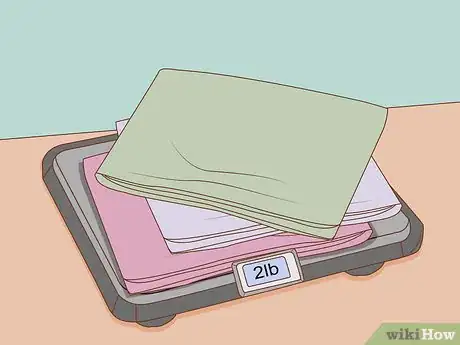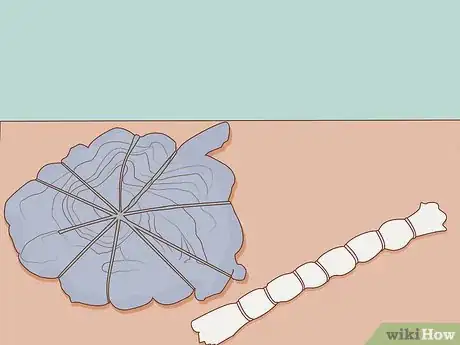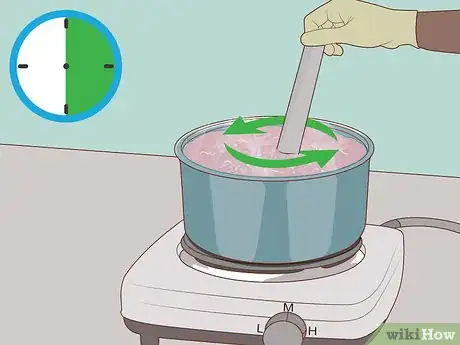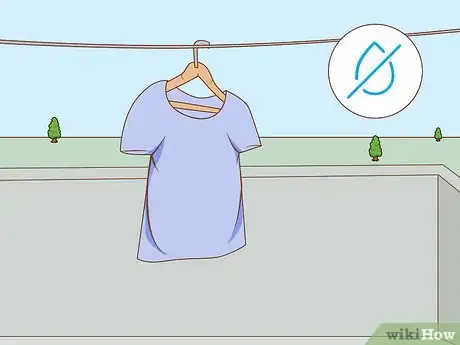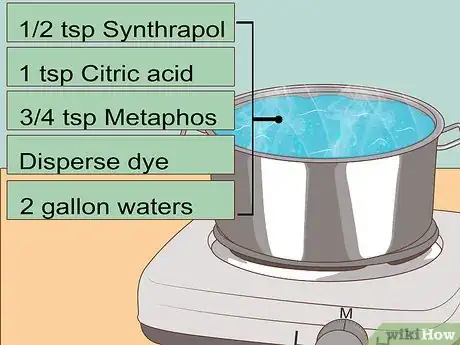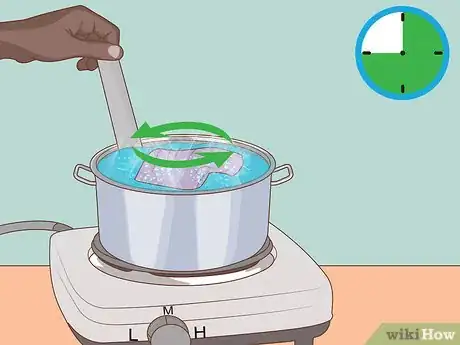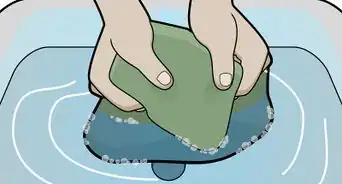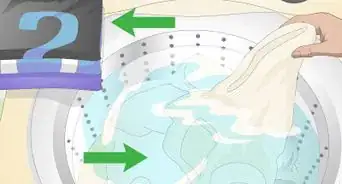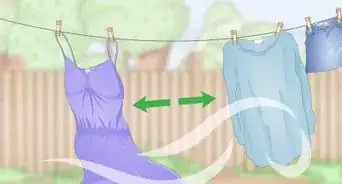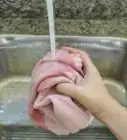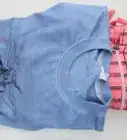wikiHow is a “wiki,” similar to Wikipedia, which means that many of our articles are co-written by multiple authors. To create this article, 19 people, some anonymous, worked to edit and improve it over time.
wikiHow marks an article as reader-approved once it receives enough positive feedback. In this case, 84% of readers who voted found the article helpful, earning it our reader-approved status.
This article has been viewed 781,024 times.
Learn more...
Polyester is an extremely difficult type of fabric to dye, especially if the garment is 100% polyester. This is because polyester is a synthetic fabric made from petroleum, and due to the manufacturing process, it is essentially plastic.[1] Therefore, polyester is hydrophobic and lacks ionic properties.[2] However, there are a couple of products that are able to dye polyester and polyester blends.
Steps
Dyeing Polyester With Rit DyeMore
-
1Weigh the garment to determine how much dye to use. Generally speaking, one bottle of DyeMore can dye up to two pounds of fabric.[3]
- Dyeing very light clothing or very dark clothing will require at least one additional bottle, so be prepared if this is the case for you.
- Polyester may require a second bottle of DyeMore, because of its synthetic makeup.
- The darker color you want at the end, the more dye you will need.
-
2Wash the garment prior to dyeing. This helps to remove finishes that might inhibit the absorption of the dye. Use warm, soapy water to wash.[4]
- Use a sink or small tub for smaller items, such as scarves and short-sleeved shirts.
- Use a larger bucket or tub for bulkier items, such as long-sleeved shirts, jackets, and pants.
Advertisement -
3Consider tying the garment up if you want to tie dye. You can create different patterns, such as rosettes, sunbursts, swirls, and so forth. Here are some ideas to get you started:
- For a simple, crumpled look, crumple your garment into a ball and secure it with a few, large rubber bands.
- For a banded effect, twist your garment into a rope, then tie some rubber bands around the rope. Keep the rubber bands several inches apart.
- To create a sunburst or swirl: pinch the center of your garment (such as shirt or handkerchief) and twist it. Keep twisting and turning the fabric until you get a shape like a cinnamon roll. Secure the garment by wrapping a few rubber bands around it.
-
4Bring 3 gallons (11.36 liters) of water to boil in a large pot on your stovetop. Because of the challenge in dyeing polyester, using a stovetop method is recommended because the dye process needs hotter temperatures in order to work.[5]
- Once the large pot is filled with 3 gallons (11.36 liters) of water, cover the pot and turn the burner to high. Heat the water to almost boiling.
- Using a cooking thermometer will be helpful, as the dye process requires a steady temperature of about 180°F (82.3°C). The thermometer will ensure that you keep the water at that temperature.
-
5Pour one bottle of DyeMore into the pot of water once it is simmering. Shake the bottle of DyeMore before adding it to the pot to make sure that the dye is incorporated. In addition to the bottle of DyeMore, add 1 teaspoon of dish washing liquid and use a large spoon to stir the mixture well.[6]
- If your fabric is white, and you want to dye it a lighter, pastel color, start with half a bottle of DyeMore. It is easier to add more dye later.
- If you plan on dyeing your fabric more than one color, pour in your lightest color first. You will need to do a separate dye bath for the other color(s).
-
6Test the color on a scrap of white cotton fabric. This helps you to see if the dye is the shade you would like.[7]
- If it is too light, then add some more dye to the mixture. You may need to add up to one more bottle. Test the color with a new scrap of white cotton fabric.
- If the color is too dark, then add more water. Then, test the color again with a new scrap of white cotton fabric.
- If you decide to add more dye, remember to shake the second bottle before pouring it in.
-
7Dip the garment into the dye bath.[8] Stir the garment slowly and continuously in the dye bath for at least 30 minutes. In order for the color to take fully in the clothing, polyester requires at least this amount of time in the dye bath. Use tongs to lift and move the clothing around in the pot. Wear rubber gloves to do this so that you do not dye your skin.
- If you plan on dyeing all of your fabric, dip it all the way into the dye bath. It should be completely submerged.
- If you plan on dyeing only part of the fabric, then dip it in only part way. Consider draping the rest of the fabric over the edge of the container.
- Keep the garment in the dye bath even if it has reached your desired color in less than 30 minutes. The color can rinse from the fabric if it is not given enough time to set in the fabric, which will make it lighter than you desired.
-
8Remove the garment from the dye bath when it reaches your desired color. Squeeze out excess dye over the pot full of the dye bath. Be sure to keep the rubber gloves on during this time, as the dye will still stain your skin. Remember that as the clothing dries, the shade of the color will lighten.[9]
- If you wrapped rubber bands around your garment to tie dye it, carefully cut those rubber bands off with a pair of scissors.
-
9Rinse the garment under warm water. While you rinse, gradually make the water cooler. Continue to rinse the article of clothing until the water runs clear.[10]
- If you want to add more colors to your garment, then you can dip it into another dye bath after you rinse it. Be sure to rinse your garment after each dye bath.
-
10Wash the garment again in warm, soapy water.[11] Rinse the garment when you are done washing it. This will remove any last remnants of excess dye.
-
11Wrap the garment in an old towel to remove excess moisture. Spread an old towel out on the floor, and align the bottom of your garment with the bottom of the towel. Roll the garment and towel together into a tube. Press down on the towel tube gently and squeeze. Try to get out as much moisture as you can.
- If you have a very large, bulky item, you may need to do this step a few more times with a fresh towel. Bulky items soak up more water than lightweight items.
-
12Hang the garment to dry. Place the hanger in a place where there is a lot of airflow, such as on a balcony. If this is not possible for you, hang it in the bathroom and turn the fan on. Be sure to place some newspaper or old towels beneath the garment to catch any drips. There is a small change that the garment still have some dye in it.
- Use a regular hanger to hang shirts and jackets.
- Use a pants hanger, or a hanger with clips, to hang pants, shirts, scarves, and handkerchiefs. Avoid draping the fabric over anything while it dries.
Dyeing Polyester With Disperse Dyes
-
1Clean the garment to prepare it for dyeing. There are two methods you can use for this, but it is important to clean the fabric in order to get it ready to absorb the disperse dye.
- Put the garment through a cycle in the washing machine on the hottest setting with ½ teaspoon of soda ash and ½ teaspoon of Synthrapol. The Synthrapol helps to clean and prepare the garment for dyeing.
- Wash the garment by hand on the stovetop with ½ teaspoon of soda ash and ½ teaspoon of Synthrapol.
-
2Tie the garment up with rubber bands if you want to tie dye. You can create different patterns, such as rosettes, sunbursts, swirls, and so on. Here are a few ideas to get you started:
- For a simple, rippled look, crumple your garment into a ball and wrap a few, large rubber bands around it to hold it together.
- For a banded effect, twist your garment into a rope and wrap some rubber bands around the rope. Keep the rubber bands several inches apart.
- To create a sunburst or swirl, pinch the center of your garment (such as shirt or handkerchief) and twist it. Keep twisting and turning until you get a shape like a cinnamon roll. Wrap a few rubber bands around the "bun" to hold it together.
-
3Dissolve the disperse dye in 1 cup of boiling water. Stir the dye powder into the boiling water, and then allow it to cool to room temperature. Once it has cooled, stir it again. Then, strain through two layers of nylon stockings before adding it to the dye bath. Depending on how light or dark you want to dye your polyester garment, there are different amounts of dye powder to use. Here are a few combinations to get you started:
- Pale/pastel: ¼ teaspoon
- Medium: ¾ teaspoon
- Dark: 3 teaspoons
- Black: 6 teaspoons
-
4Dilute 2 tablespoons of dye carrier in 1 cup of boiling water and stir. Dye carrier is necessary to achieve dark colors, but it is optional for pale or medium colors. You will add this diluted dye carrier to the dye bath later on.
-
5Fill a large pot with 2 gallons (7.57 liters) of water and bring it to 120°F (48.89°C) on the stovetop. Add the following ingredients in the order they are given once the water reaches the correct temperature. Stir the mixture after you add each ingredient.
- ½ teaspoon Synthrapol
- 1 teaspoon citric acid or 11 teaspoons distilled white vinegar
- Diluted dye carrier mixture, if using
- ¾ teaspoon Metaphos, which is optional unless you have hard water
- Dissolved and strained disperse dye
-
6Add the pre-washed garment to the dye bath. Stir the full mixture together one last time before adding the garment to it.
-
7Bring the dye bath to a rapid boil. Stir the mixture constantly while it comes to a boil. Be careful so as not to crease the fabric too much. If you do this, the dye job may not be even at the end.
-
8Once it reaches a boil, simmer the dye bath and stir intermittently for 30-45 minutes. The longer you let it sit, the darker the color will be. Remember to be gentle while you stir so that the fabric does not crease and the dye takes onto all of the garment evenly.
-
9Heat a second pot of water to 180°F (82.3°C) while you simmer the dye bath. When the garment reaches your preferred shade or color, remove it from the dye bath and transfer it to this second pot of heated water.
- Make sure that the temperature is at 180°F (82.3°C), because temperatures below this will result in an odd odor and residue on the garment.
- Be sure to fully submerge the garment in the water in order to rinse it.
-
10Discard the dye bath and refill the pot with water at 160°F (71.2°C). You are going to make a mixture to wash the fabric again before it dries.
- Add ½ teaspoon of Synthrapol to the water and stir.
- Transfer the dyed garment from the rinse pot to this pot. Stir intermittently for 5-10 minutes.
-
11Rinse the garment thoroughly in hot water. Once the water runs clear, remove excess moisture by wrapping it in a towel or wringing it out.
- Smell the garment once it is rinsed and wrung out. If it still smells like the dye carrier, then repeat steps 7 and 8 above to better remove it.
- If the garment has no odor, then hang it to dry.
- If you wrapped rubber bands around your garment to tie dye it, cut rubber bands off before you go to rinse it.
Community Q&A
-
QuestionHow do I dye something that is polyester that won't fit into a pot very well?
 Community AnswerUse your sink or bathtub. Just add a pot of boiling water to get the water hot enough.
Community AnswerUse your sink or bathtub. Just add a pot of boiling water to get the water hot enough. -
QuestionCan I dye a black polyester fabric to orange?
 Community AnswerNo. You would first have to bleach the fabric until it is practically white, depending on the shade you are attempting to achieve in your end result.
Community AnswerNo. You would first have to bleach the fabric until it is practically white, depending on the shade you are attempting to achieve in your end result. -
QuestionCan I use the pot I used to dye the polyester for food afterwards?
 Community AnswerNever use dye containers as food prep afterwards. Many ingredients in commercial dyes are toxic. Wear gloves and particle masks if using powdered dye. Keep all dye containers separate from any other use by either labeling them clearly or disposing of them afterward.
Community AnswerNever use dye containers as food prep afterwards. Many ingredients in commercial dyes are toxic. Wear gloves and particle masks if using powdered dye. Keep all dye containers separate from any other use by either labeling them clearly or disposing of them afterward.
Warnings
- Never use the same utensils you use for dyeing clothing for cooking food.⧼thumbs_response⧽
- Do not attempt to dye fabrics marked as "dry clean only." This will ruin the garment.⧼thumbs_response⧽
- Ventilate the space where you will be dyeing the clothing by opening windows. This helps the fumes from the dye to dissipate from the room.⧼thumbs_response⧽
- Only dye clothing in stainless steel or enamel pots. Pots made of other materials will stain and become ruined. The same goes for tongs and stirring utensils; these should also be stainless steel.⧼thumbs_response⧽
References
- ↑ http://schwartz.eng.auburn.edu/polyester/manufacturing.html
- ↑ http://www.pylamdyes.com/products/disperse-dyes.html
- ↑ https://www.ritstudio.com/techniques/the-basics/dyemore/
- ↑ https://www.ritstudio.com/techniques/the-basics/dyemore/
- ↑ https://www.ritstudio.com/techniques/the-basics/dyemore/
- ↑ https://www.ritstudio.com/techniques/the-basics/dyemore/
- ↑ https://www.ritstudio.com/techniques/the-basics/dyemore/
- ↑ https://www.ritstudio.com/techniques/the-basics/dyemore/
- ↑ https://www.ritstudio.com/techniques/the-basics/dyemore/
About This Article
If you want to dye polyester with Rit DyeMore, weigh the garment to figure out how much dye to use. 1 bottle of DyeMore can dye 2 pounds of fabric. Then, hand wash the fabric in warm, soapy water to remove any finishes. Next, boil 3 gallons of water, and add 1 bottle of DyeMore and 1 teaspoon of dishwashing liquid. Add the nylon and stir it slowly for 30 minutes. Rinse it with warm water, wash it again, and let it dry. Keep reading to learn how to dye polyester with a disperse dye.
